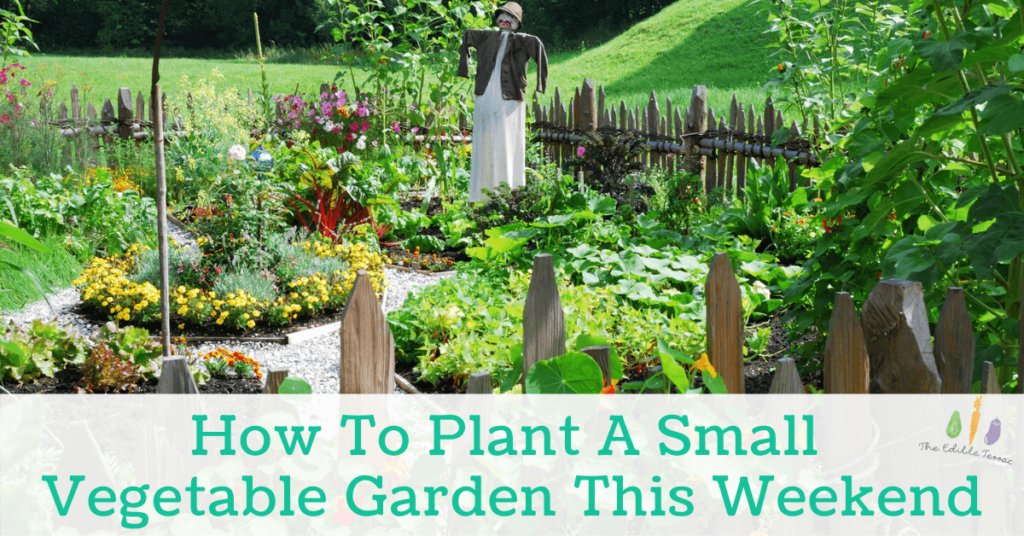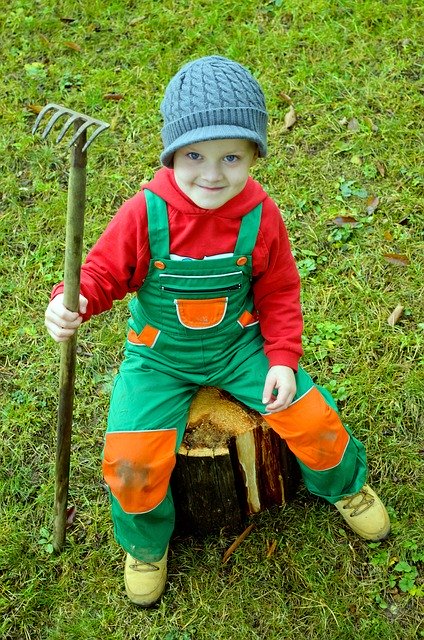Hey! By the way… TheEdibleTerrace is reader-supported. When you buy through links on our site, we may earn an affiliate commission and as an Amazon affiliate, we earn from qualifying purchases. Thanks in advance for your support!

Introduction
We all want to include more healthy foods in our family’s diets and the idea of being able to do this from the comfort of our own home is very appealing. Planting a small vegetable garden might seem like an intimidating task, but it really doesn’t have to be. In this article, we are going to show you simple ways to get your first small vegetable garden planted in just one weekend.
Things To Consider Before You Begin
Before you start planting your vegetable garden, there are a few things to take into consideration. Proper planning will ensure that your new vegetable garden will thrive and be successful.
- Decide on the location for your small vegetable garden. An area which is sheltered from the wind will be perfect but also somewhere which receives around six hours of sunlight each day. The south side of your house/yard, etc is a good place to start.
- We’ve talked about this small garden, but what is the ideal size? When you are first starting out it is a good idea to have a manageable plot, you can always extend down the line once you become more confident. A good rule of thumb is to create an 8 x 8 foot area.
You should come prepared with the correct gardening tools so that you have everything you need and will not have to pause to find extra equipment. Ideally you will need the following:
- A bow rake
- A hoe
- A hand trowel
- A shovel with a round tip
- A fork
- A hose or watering can
- Gardening gloves
- A wheelbarrow
- A spade
Check details on the first and last frosts for your local area, this can be a great resource in helping you decide which vegetables to plant at which time.
You might consider starting a vegetable garden journal in which you can store what has been planted, how your harvests turn out, the frost information you have researched and any other notes which you deem necessary. You can also draw up a planting calendar including your initial planting so that you know exactly where you are with things.
As well as gathering the necessary tools, you will need to buy some vegetable seeds or seedlings to get you started. There are so many to choose from, depending on your location and your family’s tastes will hinge on what you choose. It is worth finding out whether the vegetables you have selected should be planted direct from a seed or whether you need to purchase a seedling from your local nursery.
Now keep in mind too that some seeds can take months to germinate. So if you want vegetables to eat sooner rather than later, consider a two pronged approach. Buy the vegetable starts that you know you want now and then plant seeds for a few months down the road.
ALSO, and this is SO important. Make sure those seeds and seedlings will actually grow in your area. For example, I live in Northern Florida. It is entirely too warm for me to grow asparagus. I have been told by master gardeners not even to try! However, I can grow all types of lettuce here almost all year long.
How To Plant A Small Vegetable Garden This Weekend
Now that you are fully prepared and have everything you need, it’s time to begin crafting your masterpiece. By following these easy steps, you will have no trouble in creating a successful small vegetable garden that you can be proud of.

Dig Your Vegetable Garden
You may choose to use a raised bed, but if you are planning to create a ground level vegetable garden then you will need to start digging! You can use a tape measure to determine the correct size and mark each corner using a stick, you can then connect these with string to clearly mark out your plot. You are now ready to start digging.Using your spade, you should dig down about one spade depth and ensure that you remove any rocks, weeds or other debris as you go along. You might also consider lining the plot with some newspaper or cardboard as a way to discourage weed growth.
Finally, you should spread some compost (my favorite is mushroom compost – they call it Black Gold around here!) or manure over the entire area and rake through to create a level surface.
Plant Position
On each seed packet, you will find information about where the plant will best thrive, this should be incorporated into your plan; you will find details of the height that the plant will grow, spacing and what the plant’s light requirements are. If you are planting taller plants, I recommend putting these at the north end of your vegetable garden to prevent them from casting shade over your smaller plants.
There is no rule to say that your plants must all be in a uniform row though, feel free to mix it up and pop in a raised bed or stagger the plants. This is your garden and you should inject some personality into it.
Plant Buddies
You might want to consider creating a buddy system for your veggies as this will give them protection as well as adding to their flavor. Let’s take a look at which plants work well together.
- Tomato plants work well with basil.
- Growing lettuce, onions and radishes together can be very beneficial.
- Using rosemary, sage or oregano can assist in repelling pests as well as attracting bees which is great news for vegetables like cucumber, peas and peppers.
 Sowing
Sowing
There are certain times which are better for planting your seedlings, and these times should be observed as best as possible to reduce the risk of causing shock to the seedlings. If possible, you should plant them at a time of day when it is cool such as first thing in the morning. However, planting on an overcast day may even be a better option.
Create a space for the seedling and sprinkle a small amount of bone meal into it before putting the plant into position. You can then gently bring the soil in around the plant and firm it down. And of course, don’t forget to water!
**If you are using seeds, you should follow the packet instructions.
Benefits Of A Small Vegetable Garden
 Now that you have planted your small vegetable garden, all you need to do is take care of it, watch it flourish and of course, enjoy the delicious fruits of your labor (pun intended!). However, in the meantime, why not consider some of the benefits that your small vegetable garden will bring?
Now that you have planted your small vegetable garden, all you need to do is take care of it, watch it flourish and of course, enjoy the delicious fruits of your labor (pun intended!). However, in the meantime, why not consider some of the benefits that your small vegetable garden will bring?
- The maintenance of your small vegetable garden (watering, weeding, replanting etc) can be an enjoyable family activity that will not only keep you and the children busy but also serves as an educational activity.
- Taking care of any type of plant is a therapeutic activity and can reduce stress.
- Growing your own vegetables will be much less costly than buying the from the supermarket.
- You can grow extra vegetables to freeze or use to make chutneys and jams.
- Your own vegetables will be organic and you will be in control of how they are grown.
Conclusion
Planting a small vegetable garden in a weekend is a very achievable task provided you create a plan and stick to it. These easy to follow steps will help you in creating the perfect space for you and family to grow your very own tasty veggies!
Additional Resources
5 Steps To Getting Your Garden Started
Succession Planting: How To Extend The Growing Season
Growing A Front Yard Edible Garden – the Sneaky Way
10 Pinteresting People Give Us Steps To Grow a Vegetable Garden




